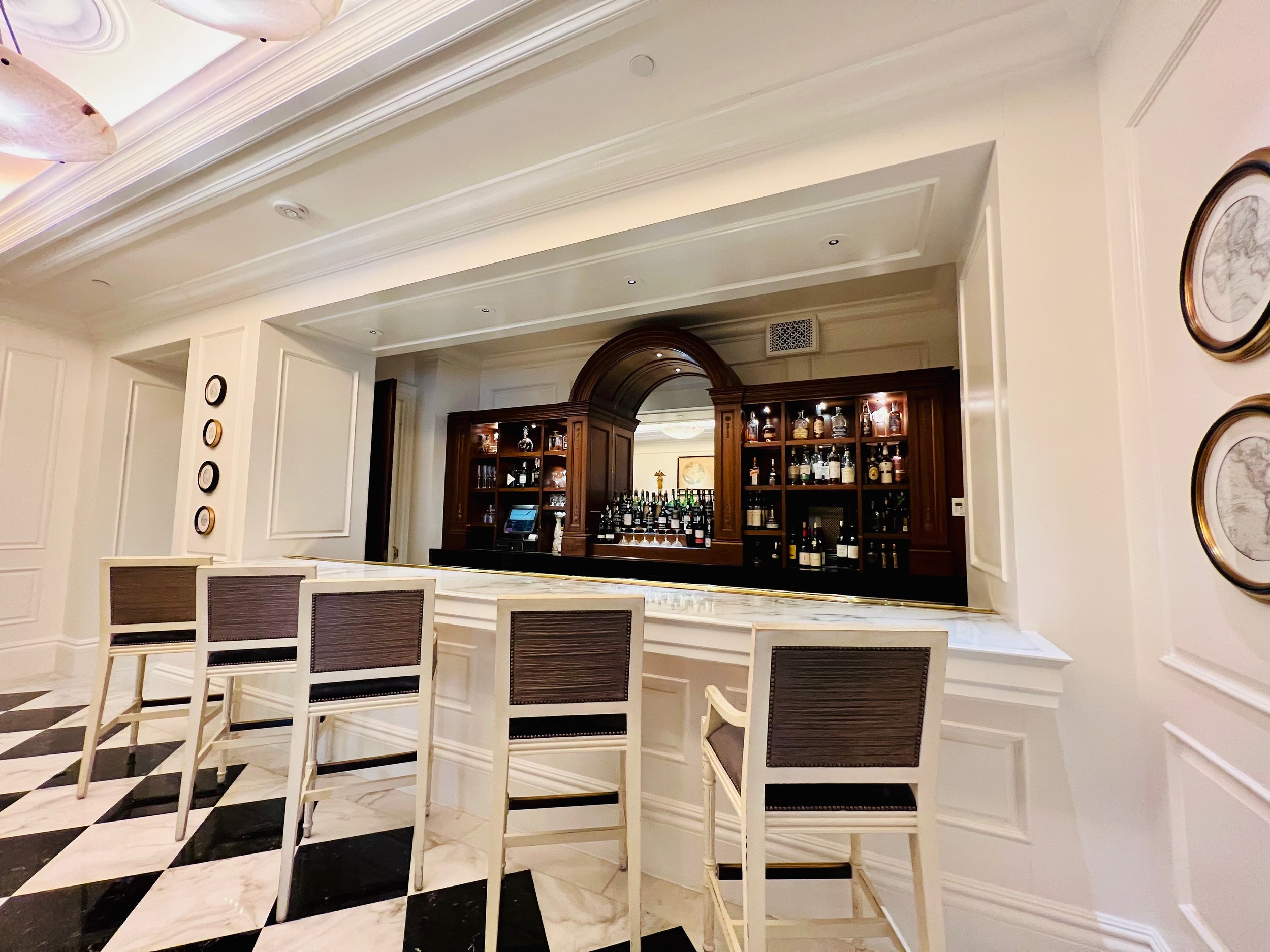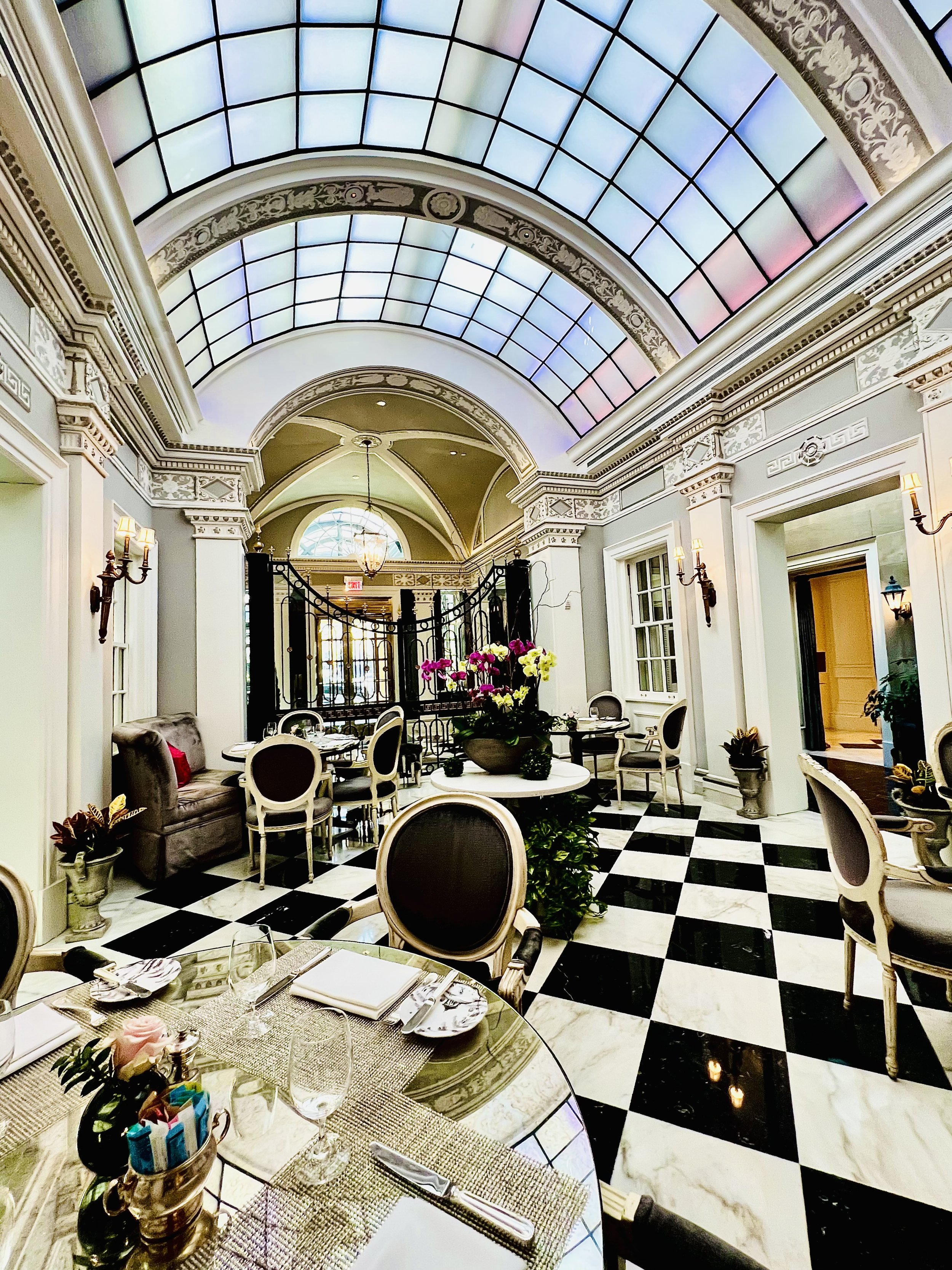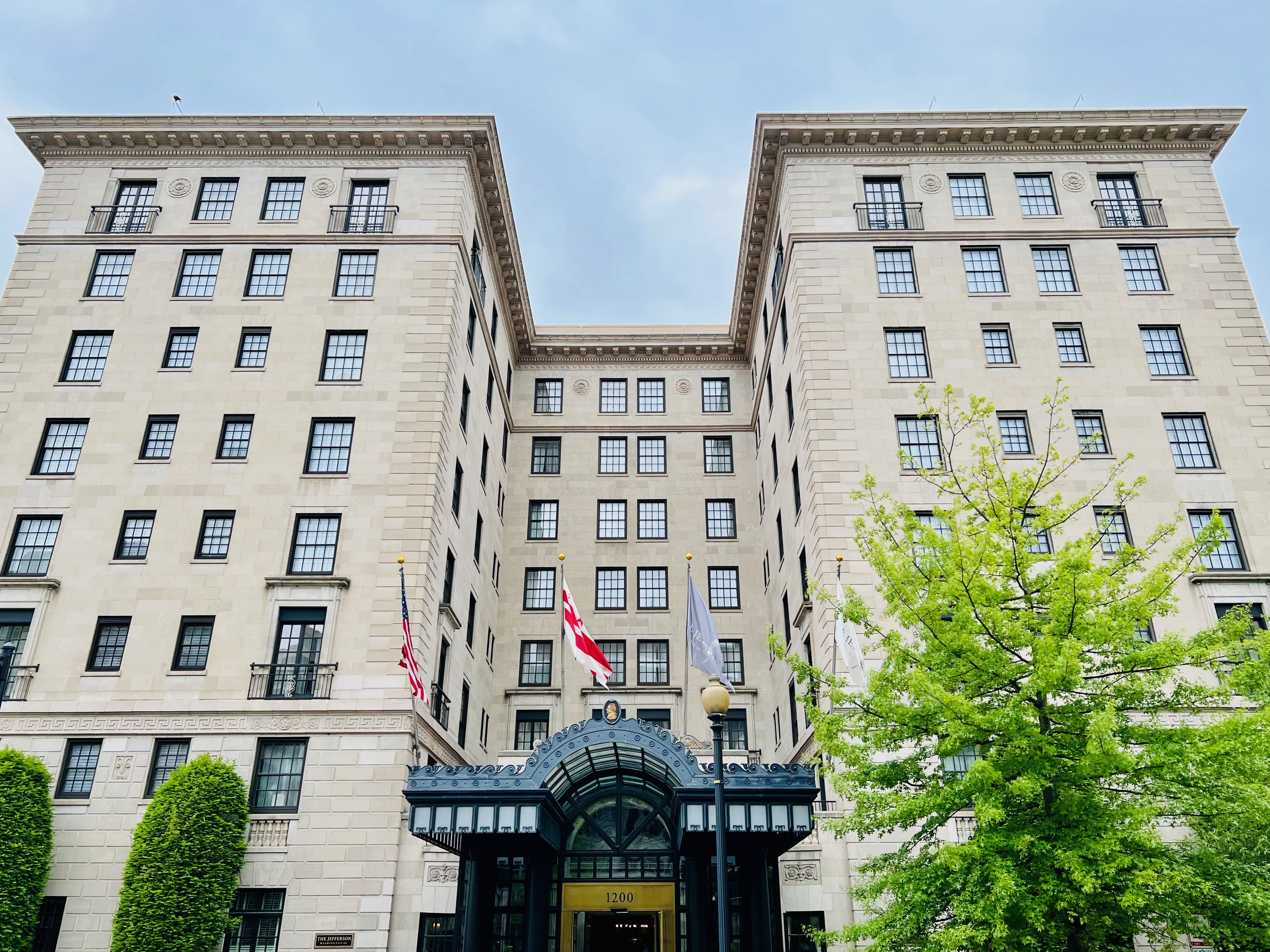The Jefferson



Its History
In 1923, Washington, DC, welcomed The Jefferson Apartments to its collection of 16th St. White House area development. Its beautiful Beaux Arts design was created by architect Jules Henri de Sibour[2][3][4][5][6] and was the first building erected between Lafayette Square and Scott Circle. The F. H. Smith Corporation, a local real estate developer of apartment and office buildings, began construction on The Jefferson, an eight-story, 74-unit apartment building, in July 1922. Cost of construction was $900,000 ($14,569,980 in 2021 dollars)
The building was named for Thomas Jefferson, the former President of the United States and Founding Father.[3][7] The building was originally owned by The Jefferson Corporation.[1] In April 1930, The Jefferson Corp. was forced into bankruptcy by its creditors. As the trial progressed, evidence emerged that the F. H. Smith Corp. had signed secret agreements to allow its chairman, G. Bryan Pitts, to occupy an entire floor of the building (17 rooms, including five baths) rent-free, which had caused The Jefferson Corporation's financial difficulties. Pitts and other F. H. Smith officers were charged with embezzlement. As the trial continued, a former Smith Corp. officer testified that he had destroyed evidence to cover up the crime. Pitts and several others were found guilty and sentenced to 23 years in prison.[8]. In 1931, Alfred Robinson Glancy, a General Motors executive, purchased the building from the bankrupt Jefferson Corp. for an undisclosed sum.[9][10]
The Jefferson partially converted to a hotel in 1941[11] to serve workers mobilizing for a potential war with Nazi Germany and Imperial Japan. It provided both short-term rentals (like a hotel) and residential needs.[3][4] It eliminated its residential services and converted completely into a hotel in 1955.[5], quickly becoming the address of choice for discerning travelers. Known today as The Jefferson, Washington, this boutique hotel has also been known as The Jefferson Hotel. It became better known after a 1980 renovation, becoming a Washington landmark.
Glancy died in 1959, and in 1960 his heirs purchased 1214 16th Street NW, a four-story building adjacent to the north side of the hotel, for use as office space.[12] By 1963, The Jefferson's 74 rooms had been subdivided, creating 150 hotel rooms.[9] The hotel's main floor sported a dining room[9] and cocktail lounge named "The Elbow Room".[13] The hotel was not considered luxurious by the standards of the day, but it had a great deal of cachet with artists, musicians, theater and movie stars, and top domestic and foreign government officials.[9]Among those who stayed there in the 1950s were actress Helen Hayes, actor Tyrone Power and orchestra conductor Leopold Stokowski.[13]
In March 1963, Glancy's heirs sold The Jefferson to the American Realty Trust Co. of Arlington, Virginia, for $1 million ($8,851,087 in 2021 dollars).[9] Famous guests at the hotel in the 1960s included comedian and pianist Victor Borge, actress Carol Channing, pianist Van Cliburn, actress Vivien Leigh, theatrical producer David Merrick, and writer Katherine Anne Porter.[11]
American Realty Trust sold The Jefferson in January 1976 to attorney and sports team owner Edward Bennett Williams for $1.8 million ($8,571,579 in 2021 dollars).[11][14][15] By this time, the hotel had created a number of large suites out of some of the smaller rooms, leaving the hotel with just 98 rooms and suites.[11] Williams began to improve the hotel's luxuriousness, emphasizing its "European style" and immaculate rooms.[15] In 1980, Williams began a multimillion-dollar, two-year renovation of the hotel.[15] The renovation replaced most of the guest-room and public space furniture with antiques, and original American artwork from the past 200 years graced walls throughout the hotel. Williams also built an extensive collection of documents signed by the hotel's namesake, Thomas Jefferson.[3][4][16]
Williams was a confidante of a number of presidents (Republican and Democrat),[17] and The Jefferson became a favorite hotel of top officials in the Reagan administration.[18] The hotel's reputation for discretion continued to attract some of the most famous visitors to the city, and in the 1980s actress Candice Bergen, writer William F. Buckley Jr., economist John Kenneth Galbraith, film director Louis Malle, and actor Jason Robards stayed there.[18] Members of President George H. W. Bush's family stayed there prior to Bush's inauguration as President,[19] and the president-elect chose most of his cabinet while staying at The Jefferson.[20] The hotel was also the home of former Senator John Tower during confirmation hearings for his unsuccessful 1989 nomination as United States Secretary of Defense.[18] Radio talk show host Larry King broadcast from the hotel the first Friday every month in the mid and late 1980s.[18]
Edward Bennett Williams died in August 1988, and his widow, Agnes Williams, sought to sell the hotel. Rose Narva, the hotel's long-time and popular managing director, organized a consortium of investors to purchase the hotel for $25 million ($54,651,007 in 2021 dollars) and retain her as the manager. Her bid was topped by the Aoki Corp., a Japanese construction and real estate investment company, which signed a letter of intent in February 1989 to purchase the "landmark" hotel for $30 million ($65,581,208 in 2021 dollars). The company subsequently backed out of the purchase agreement, apparently after real estate experts said the $30 million price would have been far too high.[21]
In April 1989, Paine Webber Realty (a subsidiary of the Paine Webber stock brokerage firm) purchased the hotel from Agnes Williams for $28 million ($61,209,128 in 2021 dollars).[19][22] This was a record per-room price for a hotel in Washington, D.C., at the time.[23] Paine Webber Realty acted as the agent for Value Enhancement Fund III,[3][4] a group of Japanese institutional investors.[3][4][22][23] The fund subsequently hired the Lancaster Group, owner and manager of luxury hotels nationwide, to manage the hotel when Narva's contract expired in 1990.[19] By this time, the hotel was charging anywhere from $175 ($363 in 2021 dollars) a night for a standard room to $1,000 ($2,074 in 2021 dollars) a night for its William French Smith Suite (which was named after the former U.S. Attorney General who once lived in the hotel).[19]
The expense of running the luxury property, however, was high, and The Jefferson generated just $550,000 ($1,202,322 in 2021 dollars) a year in earnings in 1989.[21] A year after the Lancaster Group took over, rates for a standard room had risen to $200 ($398 in 2021 dollars) to $340 ($676 in 2021 dollars) a night.[23] The hotel underwent another multimillion-dollar refurbishment about 1999.[4] Each room now featured an extensive built-in mini-bar, two telephone lines, a built-in music center, Internet access,[3] and a fax machine.[5]
In November 2000, Value Enhancement Fund III hired Loews Hotels to manage The Jefferson.[3] and the fund renovated the hotel again later that year.[3][4] As part of the refurbishment, each room now received its own unique set of furniture and furnishings.[16] This included canopy beds and mahogany and hickory armoires with built-in mini-bars, and the wood-burning fireplaces (in those rooms equipped with them) were restored to operation.[5] Each room was also outfitted with a 25-inch (64 cm) television, marble bathroom sinks, and new bed frames and mattresses.[16]. The hotel continued to attract entertainers and politicians throughout the 1990s and 2000s, such as singer and actress Barbra Streisand (who stayed there in the early 1990s).[16]. George W. Bush stayed in the hotel prior to his 2001 inauguration as President,[16]
The Jefferson was purchased in June 2005 by DC CAP Hotelier, a New York-based real estate firm.[24] Loews managed the hotel until July 2005,[5][25] after which the owners hired Kor Hotel Group, a Los Angeles-based manager of luxury hotels, as the hotel's new overseer. By now, The Jefferson had 32 suites, and had created about 2,500 square feet (230 m2) of meeting space. This space was divided among five rooms, which had occupancy limits ranging from 15 to 150 people.[5]
Kor Hotel Group began a major redesign of the hotel in 2005,[5] and The Jefferson closed in March 2007 to begin its overhaul.[26] Infusing modern day elegance and convenience into the stately Beaux Arts structure, the objective was to blend the hotel into a distinctly European and Washingtonian feel, featuring its many historical influences. In 2009, during the renovations, the building's skylight was uncovered for the first time in decades,[24][27] and the lobby's dropped ceiling was removed to expose the original barrel vault. Many of the building's structural elements were repaired, strengthened, and upgraded, and the HVAC and mechanical systems gutted and replaced.[24] The hotel was expected to reopen on September 1, 2008,[16] but much more structural deterioration had occurred than was anticipated and the hotel did not reopen until August 2009.[27]
Renovated guest bathrooms now featured television screens embedded in the mirrors[27] and deep "soaker" bathtubs,[7] while guest living and sleeping spaces now featured individualized custom drapes[28]and custom-designed beds covered in European linens[7] featuring images of Jefferson's Virginia home, Monticello.[28] The overall feel of guest-rooms was meant to reflect a Paris apartment.[28]
The hotel cocktail lounge was completely remodeled as well, and now featured an orange colored bar countertop of molded glass embedded with optical fibers that made it glow.[27][28] The hotel retained its Federalist interior design style in its public spaces, including the unique antique furniture, artwork, and displays of Jefferson-signed documents.[7] New amenities included a butler assigned to each guest-room,[27] and room service trays containing microchips that alerted staff whenever the tray was deposited in a hallway.[27][28] The cost of the renovation was not disclosed.[28]
The Jefferson reemerged after its renovation as a luxury hotel in the nation’s capital with exceptional, personalized service, continuing to emphasize its discretion and private nature.[27]. The hotel increased its prices after the renovation by about $100 ($126 in 2021 dollars) a night.[24] Off-season standard guest-room rates ran from $380 ($480 in 2021 dollars) to $450 ($568 in 2021 dollars) a night, while height-of-season rates ranged from $450 ($568 in 2021 dollars) to $650 ($821 in 2021 dollars). Suites went for $850 ($1,074 in 2021 dollars) a night. The new prices made The Jefferson one of Washington's priciest hotels, alongside the Four Seasons and The Ritz-Carlton.[28]
Today the Jefferson has 99 rooms, which includes 20 suites.[28] Rates for standard guest rooms began at $375 a night in January 2016.[6] Some suites have small, private balconies with views of the Washington Monument.[6] Two master suites, the Thomas Jefferson Suite and the Martha Jefferson Suite, occupy the top floors. The larger is the Thomas Jefferson Suite, which has five balconies and contains 1,900 square feet (180 m2) of space.[20]
The Jefferson has two restaurants, the Plume and the less formal The Greenhouse. Several small private rooms, capable of seating two or three people, open onto Plume to accommodate more private discussions among guests.[28] Plume received four stars from Forbes Travel Guide.[7] Since 2014, Ralf Schlegel has been the executive chef at Plume, which received a Michelin Star in the 2017 Michelin Guide for Washington, D.C.[29] The Jefferson's cocktail lounge is known as Quill, and Forbes Travel Guide said it is rumored to be President Barack Obama's favorite hotel space in Washington, D.C.[7].
The ground floor of the hotel also features the Book Room,[7] a reading library stocked with books either printed in the late 1700s and early 1800s.[28] The hotel has four private, obscure entrances for its celebrity or security-conscious guests.[30]
Its Architect
Photo Library Of Congress
Jules Gabriel Henri de Sibour
1872 – 1938
Jules Gabriel Henri de Sibour (December 23, 1872 – November 4, 1938) was a French architect who worked in Washington, DC. He was born in Paris, France, to Vicomte Gabriel de Sibour and Mary Louisa Johnson of Belfast, Maine.
De Sibour moved to the United States as a child. He attended St. Paul's School in New Hampshire, then earned a degree from Yale University in 1896, where he was a member of Skull and Bones.[1]. After working in New York for a time, he studied at the École des Beaux-Arts. In 1898, de Sibour married Margaret Marie Clagett, daughter of Mr. and Mrs. William H. Clagett, of Washington, DC. Jules and Margaret had three sons: Henri Louis, Jacques Blaise, and Jean Raymond.
After college, de Sibour worked with Ernest Flagg and Bruce Price in New York. He went to Paris for additional education, but after Price died in May 1903, de Sibour inherited the practice and continued work at the renamed firm Bruce Price & de Sibour. From 1908 to 1911, de Sibour maintained offices in both New York and Washington, DC. However, a year after moving to DC in 1910, de Sibour closed his New York office. From 1908 through 1922, de Sibour maintained an office in the Hibbs Building, then moved to the Edmonds Building in 1923.
De Sibour's most prominent works are grand dwellings and embassy buildings (such as the Embassy of Uzbekistan — called the Moore Residence — at 1746 Massachusetts Avenue). However, he also designed dozens of office buildings, apartment buildings, and a diverse range of structures. In 1910, de Sibour designed The Investment Building, a nine-story bank and office, constructed by J. L. Marshall at 15th Street and K Street NW. The same year he designed the McLachlen Building at 1001 G Street NW and what is now the national headquarters of the National Association of Colored Women's Clubs at 1601 R Street NW for Richard Thomas Mulligan and his wife Emily Ogston Mulligan, niece of Secretary of the Navy, George M. Robeson.[2]
In 1911, he designed a nine-story office building at 1512 H Street NW and in 1912, a four-story apartment building at 1409 15th Street NW and a five-story apartment building at 1785 Massachusetts Avenue NW. He collaborated with the Boston firm of Desmond and Lord on the Clapp Memorial Building (443 Congress Street, Portland, Maine) opened in 1920. In 1922, de Sibour designed an apartment building, remarkably similar to his design for the 1922 Hamilton Hotel. In 1923, J.H. deSibour also designed the Lee House, an eight-story hotel at the northwest corner of 15th Street and L Street NW, for the Kenwood Corporation.
Working in the Beaux-Arts style throughout his career, de Sibour's buildings are characterized by their extensive applied decoration and the French influence in their design. Additional notable buildings include the Chevy Chase Club, the University Club, the Chase's Theater and Riggs Building, W. B. Hibbs and Company Building and the Federal-American National Bank. He designed the French Embassy at 2221 Kalorama Road NW, the Wilkins House at 1700 Massachusetts Avenue NW[3] serving as the Peruvian Chancery, the Stewart Residence serving as the Embassy of Luxembourg at 2200 Massachusetts Avenue NW, and Oxon Hill Manor (1928), an estate for Sumner Welles in Oxon Hill, Maryland.
Its Architecture
Beaux-Arts architecture was the academic architectural style taught at the École des Beaux-Arts in Paris, particularly from the 1830s to the end of the 19th century. It drew upon the principles of French neoclassicism, but also incorporated Renaissance and Baroque elements, and used modern materials, such as iron and glass. It was an important style in France until the end of the 19th century.
The Beaux-Arts style evolved from the French classicism of the Style Louis XIV, and then French neoclassicism beginning with Style Louis XV and Style Louis XVI. French architectural styles before the French Revolution were governed by Académie royale d'architecture (1671–1793), then, following the French Revolution, by the Architecture section of the Académie des Beaux-Arts. The Academy held the competition for the Grand Prix de Rome in architecture, which offered prize winners a chance to study the classical architecture of antiquity in Rome.[2]
The formal neoclassicism of the old regime was challenged by four teachers at the Academy, Joseph-Louis Duc, Félix Duban, Henri Labrouste and Léon Vaudoyer, who had studied at the French Academy in Rome at the end of the 1820s. They wanted to break away from the strict formality of the old style by introducing new models of architecture from the Middle Ages and the Renaissance. Their goal was to create an authentic French style based on French models. Their work was aided beginning in 1837 by the creation of the Commission of Historic Monuments, headed by the writer and historian Prosper Mérimée, and by the great interest in the Middle Ages caused by the publication in 1831 of The Hunchback of Notre-Dame by Victor Hugo. Their declared intention was to "imprint upon our architecture a truly national character."[3]
The style referred to as Beaux-Arts in English reached the apex of its development during the Second Empire (1852–1870) and the Third Republic that followed. The style of instruction that produced Beaux-Arts architecture continued without major interruption until 1968.[2]
The Beaux-Arts style heavily influenced the architecture of the United States in the period from 1880 to 1920.[4] In contrast, many European architects of the period 1860–1914 outside France gravitated away from Beaux-Arts and towards their own national academic centers. Owing to the cultural politics of the late 19th century, British architects of Imperial classicism followed a somewhat more independent course, a development culminating in Sir Edwin Lutyens's New Delhi government buildings.
The Beaux-Arts training emphasized the mainstream examples of Imperial Roman architecture between Augustus and the Severan emperors, Italian Renaissance, and French and Italian Baroque models especially, but the training could then be applied to a broader range of models: Quattrocento Florentine palace fronts or French late Gothic. American architects of the Beaux-Arts generation often returned to Greek models, which had a strong local history in the American Greek Revival of the early 19th century. For the first time, repertories of photographs supplemented meticulous scale drawings and on-site renderings of details.
Beaux-Arts training made great use of agrafes, clasps that link one architectural detail to another; to interpenetration of forms, a Baroque habit; to "speaking architecture" (architecture parlante) in which supposed appropriateness of symbolism could be taken to literal-minded extremes. It also emphasized the production of quick conceptual sketches, highly finished perspective presentation drawings, close attention to the program, and knowledgeable detailing. Site considerations included the social and urban context.[5]
All architects-in-training passed through the obligatory stages—studying antique models, constructing analos, analyses reproducing Greek or Roman models, "pocket" studies and other conventional steps—in the long competition for the few desirable places at the Académie de France à Rome (housed in the Villa Medici) with traditional requirements of sending at intervals the presentation drawings called envois de Rome.
Beaux-Arts architecture had a strong influence on architecture in the United States because of the many prominent American architects who studied at the École des Beaux-Arts, including Henry Hobson Richardson, John Galen Howard, Daniel Burnham, and Louis Sullivan.[9]
The first American architect to attend the École des Beaux-Arts was Richard Morris Hunt, between 1846 and 1855, followed by Henry Hobson Richardson in 1860. They were followed by an entire generation. Richardson absorbed Beaux-Arts lessons in massing and spatial planning, then applied them to Romanesque architectural models that were not characteristic of the Beaux-Arts repertory. His Beaux-Arts training taught him to transcend slavish copying and recreate in the essential fully digested and idiomatic manner of his models. Richardson evolved a highly personal style (Richardsonian Romanesque) freed of historicism that was influential in early Modernism.[10]
The "White City" of the World's Columbian Exposition of 1893 in Chicago was a triumph of the movement and a major impetus for the short-lived City Beautiful movement in the United States.[11] Beaux-Arts city planning, with its Baroque insistence on vistas punctuated by symmetry, eye-catching monuments, axial avenues, uniform cornice heights, a harmonious "ensemble," and a somewhat theatrical nobility and accessible charm, embraced ideals that the ensuing Modernist movement decried or just dismissed.[12] The first American university to institute a Beaux-Arts curriculum is the Massachusetts Institute of Technology (MIT) in 1893, when the French architect Constant-Désiré Despradelle was brought to MIT to teach. The Beaux-Arts curriculum was subsequently begun at Columbia University, the University of Pennsylvania, and elsewhere.[13] From 1916, the Beaux-Arts Institute of Design in New York City schooled architects, painters, and sculptors to work as active collaborators.
Numerous American university campuses were designed in the Beaux-Arts, notably: Columbia University, (commissioned in 1896), designed by McKim, Mead & White; the University of California, Berkeley (commissioned in 1898), designed by John Galen Howard; the United States Naval Academy (built 1901–1908), designed by Ernest Flagg; the campus of MIT (commissioned in 1913), designed by William W. Bosworth; Emory University and Carnegie Mellon University (commissioned in 1908 and 1904, respectively),[14] both designed by Henry Hornbostel; and the University of Texas (commissioned in 1931), designed by Paul Philippe Cret.
While the style of Beaux-Art buildings was adapted from historical models, the construction used the most modern available technology. The Grand Palais in Paris (1897–1900) had a modern iron frame inside; the classical columns were purely for decoration. The 1914–1916 construction of the Carolands Chateau south of San Francisco was built to withstand earthquakes, following the devastating 1906 San Francisco earthquake. The noted Spanish structural engineer Rafael Guastavino (1842–1908), famous for his vaultings, known as Guastavino tile work, designed vaults in dozens of Beaux-Arts buildings in Boston, New York, and elsewhere. Beaux-Arts architecture also brought a civic face to railroads. Chicago's Union Station, Detroit's Michigan Central Station, Jacksonville's Union Terminal, Grand Central Terminal and the original Pennsylvania Station in New York, and Washington, DC's Union Station are famous American examples of this style. Cincinnati has a number of notable Beaux-Arts style buildings, including the Hamilton County Memorial Building in the Over-the-Rhine neighborhood, and the former East End Carnegie library in the Columbia-Tusculum neighborhood.
An ecclesiastical variant on the Beaux-Arts style is Minneapolis' Basilica of St. Mary,[15] the first basilica in the United States, which was designed by Franco-American architect Emmanuel Louis Masqueray (1861–1917) and opened in 1914, and a Freemason temple variant, the Plainfield Masonic Temple, in Plainfield, New Jersey, designed by John E. Minott in 1927. The main branch of the New York Public Library is another prominent example. Another prominent U.S. example of the style is the largest academic dormitory in the world, Bancroft Hall at the abovementioned United States Naval Academy.[16] The tallest railway station in the world at the time of completion, Michigan Central Station in Detroit, was also designed in the style.[17]
In the late 1800s, during the years when Beaux-Arts architecture was at a peak in France, Americans were one of the largest groups of foreigners in Paris. Many of them were architects and students of architecture who brought this style back to America.[18] The following individuals, students of the École des Beaux-Arts, are identified as creating work characteristic of the Beaux-Arts style within the United States:
Evarts Tracy of Tracy and Swartwout
Its Architectural Characteristics
Beaux-Arts architecture depended on sculptural decoration along conservative modern lines, employing French and Italian Baroque and Rococo formulas combined with an impressionistic finish and realism.
Slightly overscaled details, bold sculptural supporting consoles, rich deep cornices, swags and sculptural enrichments in the most bravura finish the client could afford gave employment to several generations of architectural modellers and carvers of Italian and Central European backgrounds. A sense of appropriate idiom at the craftsman level supported the design teams of the first truly modern architectural offices.
Characteristics of Beaux-Arts architecture included:
Flat roof[4]
Rusticated and raised first story[4]
Hierarchy of spaces, from "noble spaces"—grand entrances and staircases—to utilitarian ones
Arched windows[4]
Arched and pedimented doors[4]
Classical details:[4] references to a synthesis of historicist styles and a tendency to eclecticism; fluently in a number of "manners"
Symmetry[4]
Statuary,[4] sculpture (bas-relief panels, figural sculptures, sculptural groups), murals, mosaics, and other artwork, all coordinated in theme to assert the identity of the building
Classical architectural details:[4] balustrades, pilasters, festoons, cartouches, acroteria, with a prominent display of richly detailed clasps (agrafes), brackets and supporting consoles
Subtle polychromy
Become A Donor Or Advertiser

















